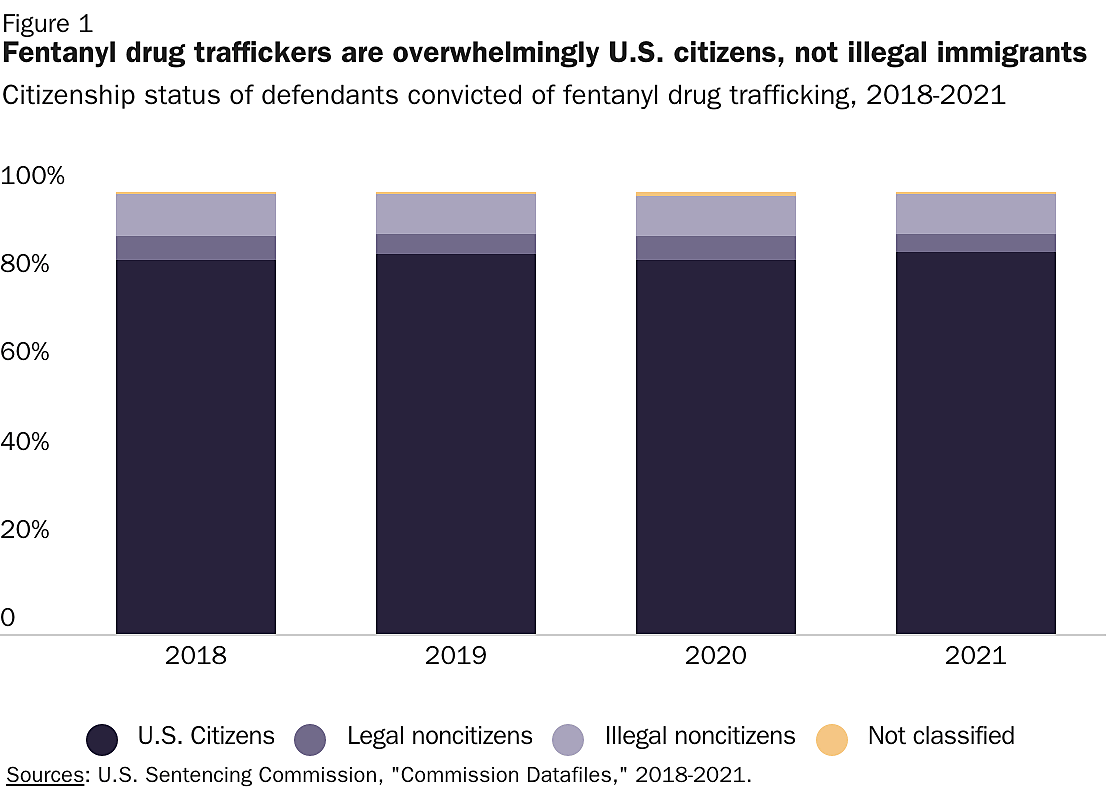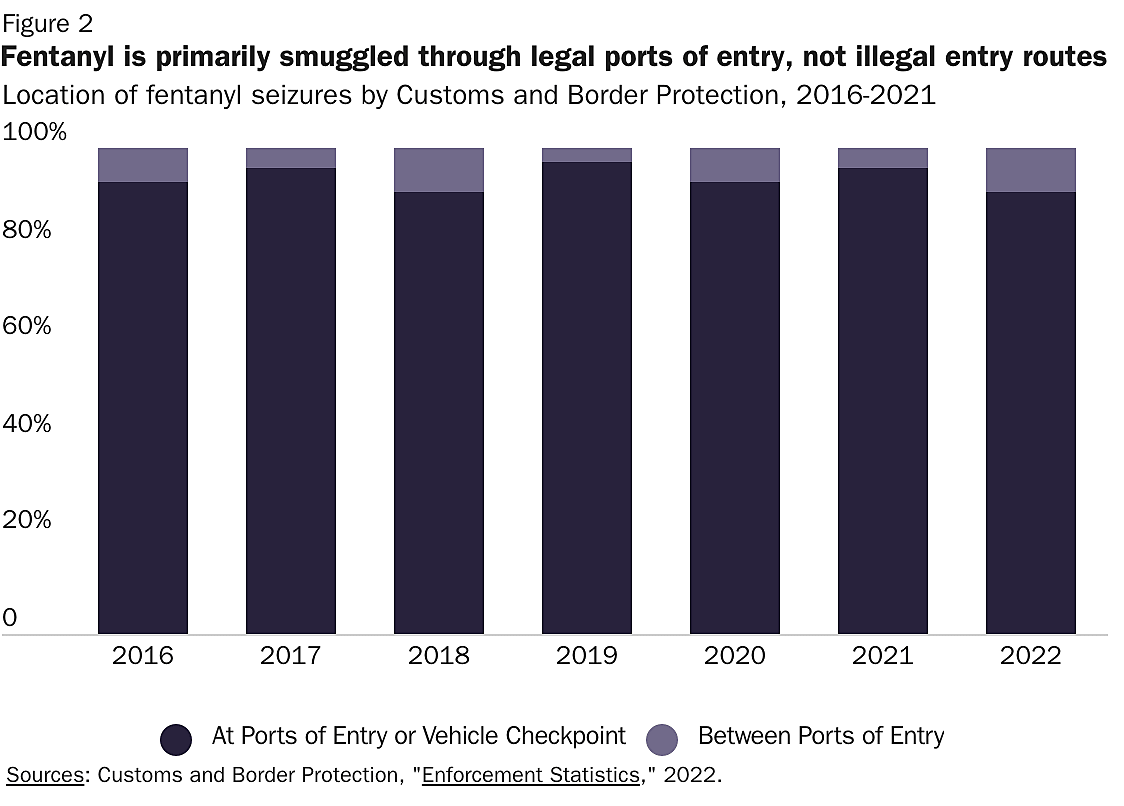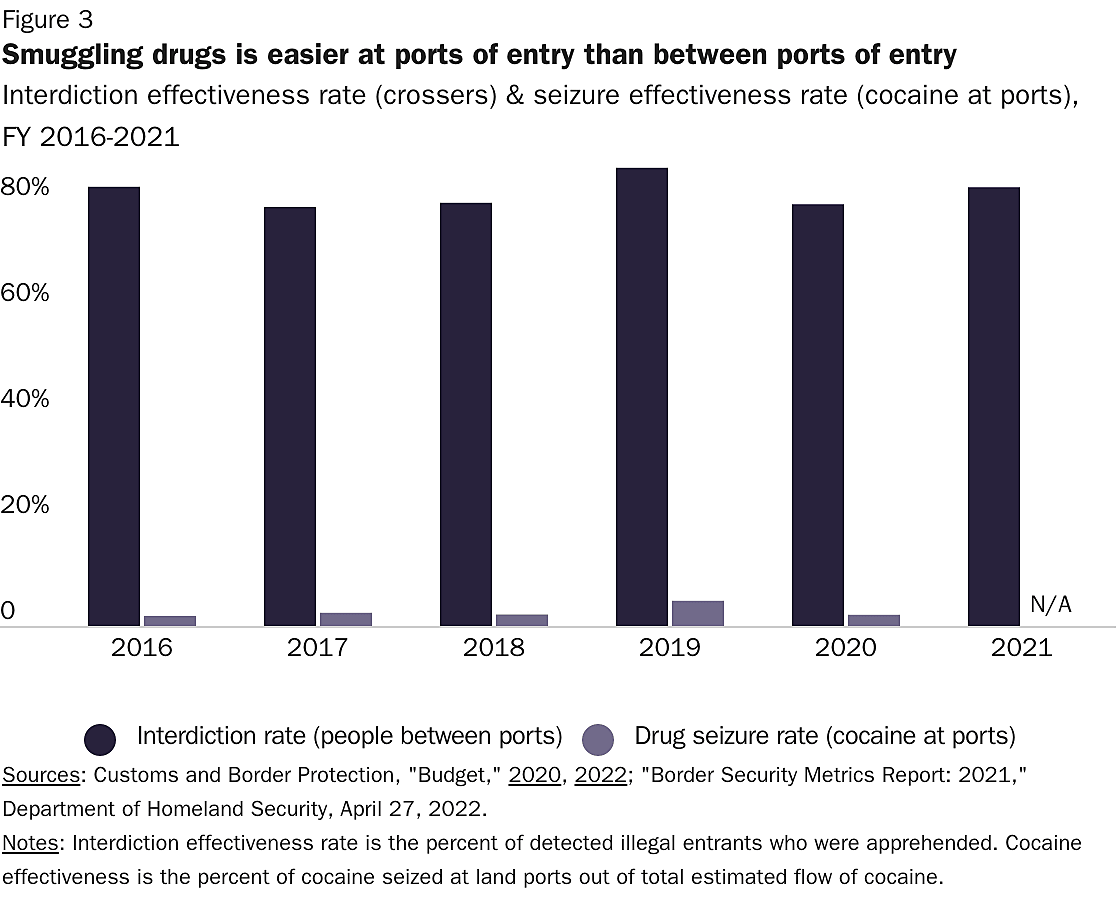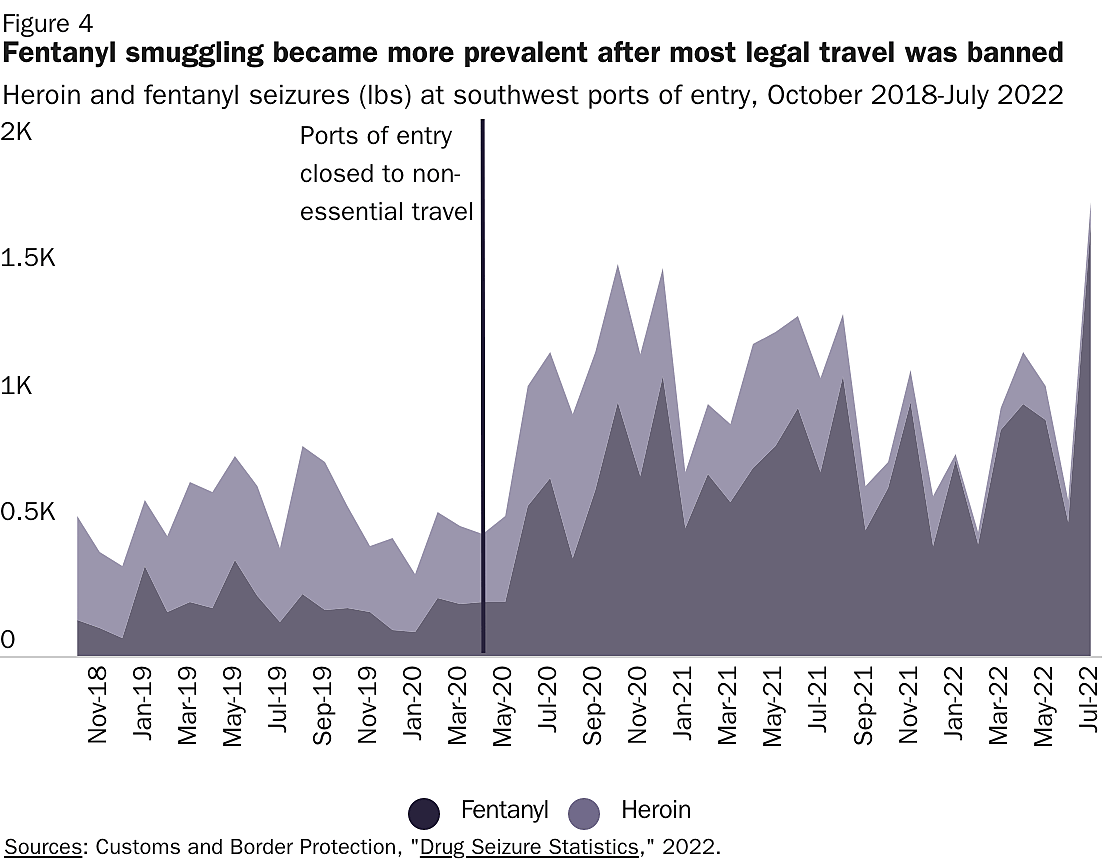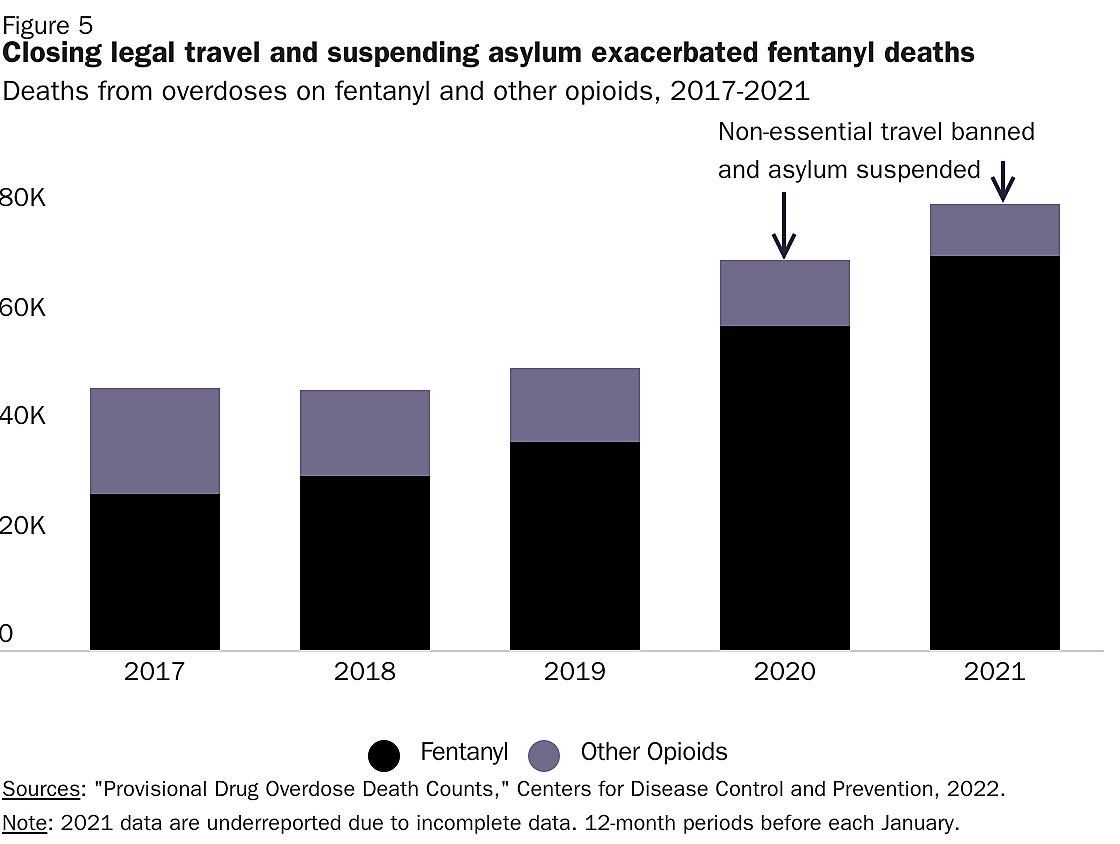This post has been updated with more recent numbers here.
Fentanyl overdoses tragically caused tens of thousands of preventable deaths last year. Many politicians who want to end U.S. asylum law claim that immigrants crossing the border illegally are responsible. An NPR-Ipsos poll last week found that 39 percent of Americans and 60 percent of Republicans believe, “Most of the fentanyl entering the U.S. is smuggled in by unauthorized migrants crossing the border illegally.” A more accurate summary is that fentanyl is overwhelmingly smuggled by U.S. citizens almost entirely for U.S. citizen consumers.
Here are facts:
- Fentanyl smuggling is ultimately funded by U.S. consumers who pay for illicit opioids: nearly 99 percent of whom are U.S. citizens.
- In 2021, U.S. citizens were 86.3 percent of convicted fentanyl drug traffickers—ten times greater than convictions of illegal immigrants for the same offense.
- Over 90 percent of fentanyl seizures occur at legal crossing points or interior vehicle checkpoints, not on illegal migration routes, so U.S. citizens (who are subject to less scrutiny) when crossing legally are the best smugglers.
- The location of smuggling makes sense because hard drugs at ports of entry are about 97 percent less likely to be stopped than are people crossing illegally between them.
- Just 0.02 percent of the people arrested by Border Patrol for crossing illegally possessed any fentanyl whatsoever.
- The government exacerbated the problem by banning most legal cross border traffic in 2020 and 2021, accelerating a switch to fentanyl (the easiest-to-conceal drug).
- During the travel restrictions, fentanyl seizures at ports quadrupled from fiscal year 2019 to 2021. Fentanyl went from a third of combined heroin and fentanyl seizures to over 90 percent.
- Annual deaths from fentanyl nearly doubled from 2019 to 2021 after the government banned most travel (and asylum).
It is monstrous that tens of thousands of people are dying unnecessarily every year from fentanyl. But banning asylum and limiting travel backfired. Reducing deaths requires figuring out the cause, not jumping to blame a group that is not responsible. Instead of attacking immigrants, policymakers should focus on effective solutions that help people at risk of a fentanyl overdose.
U.S. Citizen Consumers Fund Fentanyl Smuggling
U.S. consumer payments for illicit opioids ultimately fund fentanyl smuggling. Consumers pay retail dealers who pay wholesalers, and the cash is then transferred back in bulk cash form to Mexico. These funds are then used to pay smugglers to bring drugs back into the United States again. The best evidence indicates that about 99 percent of U.S. consumers of fentanyl (or products containing fentanyl) are U.S. citizens.[i] Noncitizens appear to be about 80 percent less likely to be fentanyl consumers than their share of the population would predict. Fentanyl smuggling is almost entirely conducted on behalf of U.S. citizen consumers. Of course, consumers would prefer much safer and legal opioids over illicit fentanyl, but the government has unfortunately forced them into the black market with few safe options.
U.S. Citizens Are Fentanyl Traffickers
Fentanyl is primarily trafficked by U.S. citizens. The U.S. Sentencing Commission publishes data on all federal convictions, which includes demographic information on individuals convicted of fentanyl trafficking. Figure 1 shows the citizenship status of fentanyl traffickers for 2018 to 2021. Every year, U.S. citizens receive the most convictions by far. In 2021, U.S. citizens accounted for 86.3 percent of fentanyl trafficking convictions compared to just 8.9 percent for illegal immigrants.
Note that since trafficking involves movement from Mexico to the United States, it is unclear how to measure the likelihood of conviction for a noncitizen without U.S. lawful immigration status or citizenship since the denominator would include most Mexicans in Mexico as well as anyone who crosses through Mexico. But regardless, the reality is that people with U.S. citizenship or residence traffic the vast majority of fentanyl, not illegal border crossers specifically or illegal immigrants generally.
Indeed, this appears to be the case even for the most high-profile cases. Aaron Reichlin-Melnick of the American Immigration Council analyzed every Customs and Border Protection press release mentioning fentanyl over a 6‑month period and found just 3 percent involved illegal immigrants. This means that the agency itself believes the most important smugglers are U.S. citizens.
U.S. Citizens Bring Fentanyl Through Legal Crossing Points
That U.S. citizens account for most fentanyl trafficking convictions is not surprising given the location of fentanyl border seizures. Over 90 percent of fentanyl border seizures occur at legal border crossings and interior vehicle checkpoints (and 91 percent of drug seizures at checkpoints are from U.S. citizens—only 4 percent by “potentially removable” immigrants). In 2022, so far, Border Patrol agents who were not at vehicle checkpoints accounted for just 9 percent of the fentanyl seizures near the border (Figure 2). Since it is easier for U.S. citizens to cross legally than noncitizens, it makes sense for fentanyl producers to hire U.S. citizen smugglers.
The DEA reports that criminal organizations “exploit major highway routes for transportation, and the most common method employed involves smuggling illicit drugs through U.S. [ports of entry] in passenger vehicles with concealed compartments or commingled with legitimate goods on tractor-trailers.” Several agencies including CBP, ICE, and DHS intelligence told Congress in May 2022 the same thing: hard drugs come through ports of entry.
Some people posit that less fentanyl is interdicted between ports of entry because it is more difficult to detect there. But the opposite is true: fentanyl is smuggled through official crossing points specifically because it is easier to conceal it on a legal traveler or in legal goods than it is to conceal a person crossing the border illegally. Customs and Border Protection estimates that it caught 2 percent of cocaine at southwest land ports of entry in 2020 (the only drug it analyzed), while it estimated that its interdiction effectiveness rate for illegal crossers was about 83 percent in 2021 (Figure 3).[ii] This means that drugs coming at a port of entry are about 97 percent less likely to be interdicted than a person coming between ports of entry, and this massive incentive to smuggle through ports would remain even if Border Patrol was far less effective at stopping people crossing illegally than it now estimates that it is.
Closing Ports Increased Fentanyl Smuggling
During the early days of the pandemic, the Trump administration drastically restricted legal travel to the United States, banning nonessential travel through land ports of entry from Mexico in particular in late-March 2020. Because there were fewer opportunities to traffic drugs at ports of entry, traffickers switched to trafficking more fentanyl. Because fentanyl is at least 50 times more potent per pound than heroin and other drugs, smugglers need fewer trips to supply the same market. The seizure data demonstrate the change in tactics. From October 2018 to February 2020, about a third of fentanyl and heroin seizures at southwest ports of entry were fentanyl with no clear upward trend. By the time the travel restrictions were ended (at least for vaccinated travelers) in January 2022, over 90 percent of heroin-fentanyl seizures were fentanyl. Unfortunately, the market shift has continued. The absolute amount of fentanyl being seized quadrupled (Figure 4).
The United Nations Office on Drugs and Crime reported that in mid-2020, as a result of travel restrictions, “Many countries have reported drug shortages at the retail level, with reports of heroin shortages in Europe, South-West Asia and North America in particular” and that “heroin users may switch to substances such as fentanyl.” The DEA predicted in 2020 that “additional restrictions or limits on travel across the U.S.-Mexico border due to pandemic concerns will likely impact heroin DTOs [drug trafficking organizations], particularly those using couriers or personal vehicles to smuggle heroin into the United States,” leading to “mixing fentanyl into distributed heroin.”
Unsurprisingly, the increased reliance on fentanyl has increased fentanyl deaths. Indeed, it appears that the border closures rapidly accelerated the transition from heroin to fentanyl, leading to tens of thousands of additional deaths per year (Figure 5). Note that 2021 data undercount the true number of deaths because not all locations have reported. Nonetheless, the annual number of fentanyl deaths have nearly doubled between 2019 and 2021. Banning asylum under Title 42 of the U.S. code probably had no effect on these trends, but it certainly did not help reduce fentanyl deaths, as some have claimed.
Asylum Seekers Don’t Aid Fentanyl Smuggling
Fentanyl smuggling is not a reason to end asylum. The people arrested by Border Patrol are not smuggling fentanyl. Just 279 of 1.8 million arrests by Border Patrol of illegal border crossers resulted in a fentanyl seizure—too small of a percentage (0.02 percent) to appear on a graph—and many of these seizures occurred at vehicle checkpoints of legal travelers in the interior of the United States.
Nonetheless, some officials have asserted that asylum seekers distract Border Patrol from drug interdiction efforts. If asylum seekers were indirectly aiding drug smuggling, however, we would expect the effect to show up in the seizure trends by changing the locations, times, or amounts of the seizures in some way. But drug seizure trends simply do not deviate measurably with greater arrests of asylum seekers. This is true on several different metrics: across time, between sectors, along mile-distance from the border, or the share of seizures at ports of entry versus between them. If the administration legalized asylum at ports of entry, even this hypothetical problem would disappear.
Aggressive Drug Interdiction Exacerbates Fentanyl Smuggling
The fentanyl problem is a direct consequence of drug prohibition and interdiction. As my colleague Dr. Jeff Singer has written:
Fentanyl’s appearance in the underground drug trade is an excellent example of the “iron law of prohibition:” when alcohol or drugs are prohibited they will tend to get produced in more concentrated forms, because they take up less space and weight in transporting and reap more money when subdivided for sale.
Fentanyl is at least 50 times more powerful per pound than heroin, which means you have to smuggle nearly 50 pounds of heroin to supply the market that a single pound of fentanyl could. This is a massive incentive to smuggle fentanyl, and the more efforts are made to restrict the drug trade, the more fentanyl will be the drug that is smuggled. The DEA has even admitted, “The low cost, high potency, and ease of acquisition of fentanyl may encourage heroin users to switch to the drug should future heroin supplies be disrupted.” In other words, heroin interdiction makes the fentanyl problem worse.
Conclusion
Border enforcement will not stop fentanyl smuggling. Border Patrol’s experience with marijuana smuggling may provide even clearer evidence for this fact. Marijuana is the bulkiest and easiest-to-detect drug, which is why it was largely trafficked between ports of entry. Despite doubling the Border Patrol and building a border fence in the 2000s in part to combat the trade, the only thing that actually reduced marijuana smuggling was U.S. states legalizing marijuana. It is absurd to believe that interdiction will be more effective against a drug that is orders of magnitude more difficult to detect.
The DEA plainly stated in 2020 that fentanyl “will likely continue to contribute to high numbers of drug overdose deaths in the United States” even with the ban on asylum and travel restrictions. But ending asylum or banning travel has been worse than useless. These policies are both directly and indirectly counterproductive: first directly by incentivizing more fentanyl smuggling and then indirectly by distracting from the true causes of the crisis.
My colleagues have been warning for many years that doubling down on these failed prohibition policies will lead to even worse outcomes, and unfortunately, time has repeatedly proven them correct. The only appropriate response to the opioid epidemic is treatment of addiction. But for this to be possible, the government must adopt policies that facilitate treatment and reduce the harms from addiction—most importantly deaths. To develop these policies, policymakers need to ignore the calls to blame foreigners for our problems.
Notes
[i] This is based on overdose statistics, and last year, fentanyl caused 88 percent of opioid overdose deaths.
[ii] The cocaine seizure effectiveness rate includes an estimate of all cocaine that escaped detection, while the interdiction effectiveness rate for people only includes detected crossings. Including undetected crossings would lower the effectiveness rate for people, but because many arrests are the same person crossing after a prior arrest (27 percent in 2021), the interdiction effectiveness rate is a better estimate of the likelihood of being arrested during a first attempt, which would be all that is necessary to disrupt a drug smuggling attempt. Regardless, in 2020, DHS estimated an apprehension rate that included undetected crossings of 66.2 percent compared to 79.4 percent using only detected crossings. This would mean that drugs were only 96.8 percent rather than 97.4 percent less likely to be apprehended.
